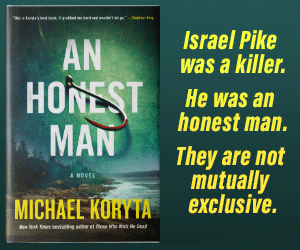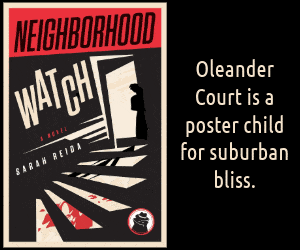
I live in a small town, Poughkeepsie, New York, which is located on the banks of the Hudson River halfway between New York City and Albany. I was born and raised here, and now reside here with my husband in the stone house built by my grandparents in 1941. During my adult life, I’ve lived in other places, from New York City to Ann Arbor, Michigan, yet the magnetic pull of the Hudson Valley has always drawn me home. It is the essence of a place flowing through my veins like blood, and an unexpected brutal event severing that vein, that drove me to write my debut thriller, THE MIDNIGHT CALL. In my novel, the life of a young, expectant attorney living in Poughkeepsie is disrupted when her mentor, a popular high school teacher, commits what appears to be a random act of violence and requests her help. As a writer, my own brush with true crime inspired me to write THE MIDNIGHT CALL, which is based upon a gruesome homicide committed in Poughkeepsie. As a reader, I’ve enjoyed the dark stories of mystery, murder and mayhem in small American towns, like mine, for years. Here are five stories that inspired me write small town thrillers based upon true crimes:
1. TO KILL A MOCKING BIRD by Harper Lee

I can hear the gasps of horror over my suggestion that “Mockingbird,” designated by PBS as the “Most Beloved Book in America,” is a true crime novel. What blasphemy! However, when I taught Law and Literature at the University of Detroit Mercy Law School, my class examined this story of the consummate literary American lawyer, Atticus Finch, who believed in the innocence of a black man accused of rape during the Great Depression-Era Macomb, Georgia. Lee drew upon her father, Amasa Coleman Lee, who in 1919 unsuccessfully defended two black men accused of murder. Lee, like me, attended law school and many of the elements contained in “Mockingbird” parallel our country’s struggle with civil rights in the 1950’s. The case of the “Scottsboro Boys” may have influenced the character of Tom Robinson, the man accused of raping Mayella Ewell, a white woman in Lee’s book. In Scottsboro, nine black youths were arrested on a train passing through Point Rock, Alabama, when two white women claimed to have been raped by them to avoid prostitution charges. All but one of the defendants was sentenced to die in the Alabama electric chair. In “Mockingbird,” Atticus Finch insists on telling the truth even though he knows he will fail. The telling of the truth is essential to his honor, and inevitably life threatening for his children, Jem and Scout. In “The Midnight Call” my protagonist, Jessie Martin seeks the truth behind the murder allegedly committed by her mentor and confidante, Terrence Butterfield, and she embarks on a search, unaware that it will threaten her career, her life and her unborn child as well.
2. IN COLD BLOOD by Truman Capote

When I first read IN COLD BLOOD, I was so overcome with Capote’s groundbreaking book that I didn’t know if I was reading fact or fiction. In the telling of the murder of the Clutter family of rural Holcombe, Kansas, Capote investigates the minds of the killers and their prey along with the capture, trial and execution of the murderers. The book read like a novel with its brilliant characterization, setting and plot, but there was an undertone of sadness for the ruthless killings. The story was chilling and I couldn’t put it down. Capote, jealous of his friend Harper Lee’s success with “Mockingbird” dedicated the book to her, but neglected to acknowledge her extensive research on the project. She was allegedly angered by this snub and their relationship deteriorated after the publication of IN COLD BLOOD. I can’t blame her. At times, Capote expressed sympathy toward the plight of the killers, Perry Smith and Dick Hickcock, raising the question of nurture versus nature. Can a man be held responsible for his actions when his environment has neglected him? I have tried to apply the same lens to my antagonist, Terrence Butterfield, the charming, charismatic teacher who brutally kills a teenager trespassing through his yard late one August night. The reader is asked to consider whether hidden mental health issued plagued Butterfield throughout his life or whether he was a psychopathic monster-in-disguise all along.
3. MIDNIGHT IN THE GARDEN OF GOOD AND EVIL by John Berendt

Savannah, Georgia is my favorite big city with a small town atmosphere. The gentility of the Spanish Moss dripping from the gnarly limbs of the Live Oaks, the taste of deep fried shrimp and grits, and the smell of salt water taffy nab me every time I’m there, which is about once a year. John Berendt weaves the slow pace of the city with its southern charm, eccentricities, sexual mores, comedy of manners and the power of gossip into “Midnight,” creating another creative non-fiction work. I immediately read the book upon its release and hopefully Mr. Behrendt appreciated my spreading the sparkling reviews to my friends and family. This is one of the few books, like “Mockingbird,” that I’ve read multiple times. “Midnight” begins with a portrait of Jim Williams, an antiques dealer, who allegedly shot and killed a small-time hustler, Danny Hanaford, his occasional employee. While reconstructing Danny’s murder, the author conjures the decadence of Savannah society and depicts a ghoulish cast of characters ranging from a voodoo priestess to a transvestite to the author inserting himself as an expat Yankee in this southern Sodom and Gomorrah. It’s a legal thriller that makes you wonder whether Williams is guilty or innocent, but captures a strong sense of place. Could this murder have occurred anywhere else? Similarly, the murder of Ryan Paige in “The Midnight Call” offers the same question; could the murder have happened anywhere but Poughkeepsie, New York with its beauty and warts?
4. MURDER ON THE ORIENT EXPRESS by Agatha Christie

I owe my addiction to crime thrillers to the Grand Dame of Mystery – Agatha Christie. I used to devour her books like popcorn at a movie. Many consider her plots and characters as pedestrian, but I disagree. Her novels transported me to exotic, faraway places, and allowed me to enter the mind of one of the world’s greatest detectives and to use my mind to solve the complicated crimes. In “Orient Express,” the well-mustachioed Belgian detective Hercule Poirot solves the mystery of the grisly stabbing of an American tycoon traveling on the infamous Orient Express. When Poirot searches the dead man’s compartment, he discovers a burnt piece of paper containing the name “Daisy Armstrong.” Daisy had been the 3 year-old heiress who had been kidnapped, ransomed and murdered. Even the official Agatha Christie website acknowledges that the “trial of the 20th century” – the Lindbergh baby kidnapping – inspired the novel’s subplot. Lindbergh’s baby son, Charles Jr., had been taken from his crib in the middle of the night from the Lindbergh’s suburban Hopewell, New Jersey mansion. After months of unsuccessful rescue attempts, the child’s corpse was discovered near the Lindbergh’s home. Crime continues to live in the collective consciousness of Hopewell, New Jersey, as it does in mine. In my hometown, we refer to “The People Vs. Albert Fentress” as one of the most infamous murder cases in our city’s history. In 1979, Fentress, a popular Middle School teacher, horrifically murdered a teenager trespassing through his yard. This local homicide became the seed of the idea for “The Midnight Call,” along with the legal maneuvering, allegations of legal impropriety and the surprising outcome to the case, which I can’t reveal – no spoiler’s here.
5. A DEATH IN BELMONT– Sebastian Junger

In A DEATH IN BELMONT, Sebastian Junger tells the story of his life as a young boy in Belmont, Massachusetts, an idyllic suburb of Boston, in the early 1960’s. In stark contrast, he relates the series of murders by strangulation occurring throughout the Boston area by a man nicknamed “The Boston Strangler.” By amazing coincidence, the man who later confessed to the crime, Albert DeSalvo, had been working at the Junger’s home as a carpenter during the time of the murderers. Junger’s first-hand knowledge of DeSalvo, and his ease with him, parallels my own “true crime” experience. In 1969, I attended Forbus Junior High School in Poughkeepsie and my World History teacher was Albert Fentress. As I mentioned above, ten years later Fentress committed murder, and his actions rocked our small town, and personally struck home. We all wondered whether we had ever really known Fentress and whether any of us had been in danger. These themes are woven into fabric of my novel and I hope that my readers will question how well they really know the people in their lives -or- how well they really know the people they love.





